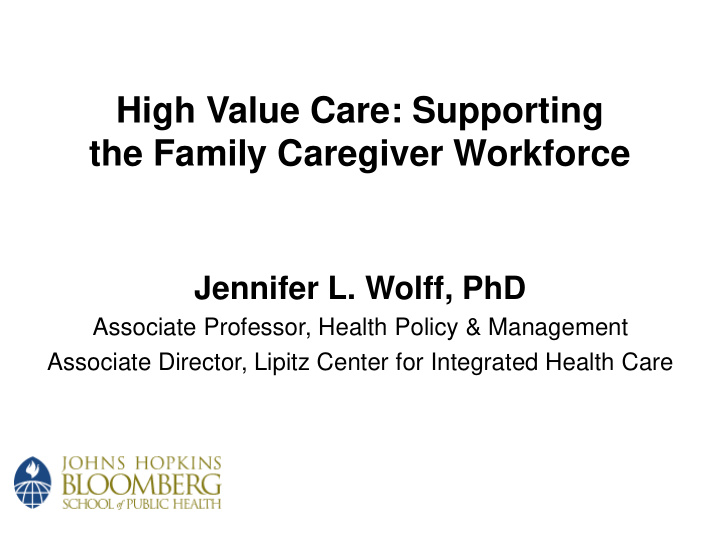



High Value Care: Supporting the Family Caregiver Workforce Jennifer L. Wolff, PhD Associate Professor, Health Policy & Management Associate Director, Lipitz Center for Integrated Health Care
Health-Related Responsibilities Assumed by Family Caregivers Role Function Attendant Provide personal care Administrator Manage household Health Provider Deliver medical care Companion Provide emotional support Driver Facilitate transportation Advocate Request services Navigator Coordinate care across providers and care settings Coach Encourage patient self care activities Technical Facilitate patient Interpreter understanding Patient Extender Facilitate provider understanding From: Wolff J. Supporting and sustaining the family caregiver workforce for older Americans: Commissioned Paper. 2007:35. Located at: Background Paper for IOM Report: Retooling for an Aging America.
Unpaid. Unappreciated. Untrained. Undercounted. Exhausted. But vital. “America’s stealth weapon against chronic illness is a 46-year-old woman with a family, a high-school degree, a full-time job and a household income of $35,000. She has no particular training in health care. And, to tell you the truth, sometimes she doesn’t feel that great herself…” -- AMA Medical News, 2001
No Help (3.8 million) Some Help (4.4 million) Substantial Help (6.5 million) 26.1% 29.8% 44.1% 28.1 26.7% 15.5% 15.1 8.3 7.6% Mean hours per week Used Supportive Services Source: 2011 National Health and Aging Trends Study and National Study of Caregivers.
Caregiver Helps Older Adult with Health Care Activities : No Help Some Help Substantial Help 55% 44% 35% 33% 33% 30% 22% 20% 20% 19% 13% 12% 7% 6% 4% Emotional Physical Financial Participation Missed Work in Difficulty Difficulty Difficulty Impacts Past Month Source: 2011 National Health and Aging Trends Study and National Study of Caregivers.
“If a doctor wants some alone time with [Patient] , that’s fine. But the fact of the matter is he’s not going to remember what was talked about…The other big problem is that doctors ask questions and he doesn’t know the answer . What medications are you on and for why? Those kinds of questions he can’t answer. I can, and then sometimes the doctor gets angry when I answer and they say, “Let him answer,” but the problem is he doesn’t have the answer . The fact of the matter is he ’ s not going to remember what to ask, and if I write a note he might not remember to look at it . You can ’ t pin a note to an intelligent, grown man ’ s sweater. And you ’ ve been to two doctors, three doctors in the week, and they ask you the exact same question, and they go over the medications in incredible, excruciating detail and it’s all networked because it’s [Provider System] and it certainly didn ’ t change since yesterday or earlier today . It ’ s just like are you kidding me? There are things we would rather be doing than sitting here . ” --Wife of 87 year-old man with mild cognitive impairment
Moving Toward Person & Family Centered Care Face-to-Face Communication: • Build on patient-directed strategies (Kinnersley BMJ 2008) to elicit & align patient-family goals and expectations for care (Wolff JAGS 2014) Electronic Communication: • Facilitating transparency, respecting patients’ preferences though shared access to the patient portal (Zulman Annals Intern Med 2011; Sarkar JAMA 2014; Wolff JAMIA 2016) Care Delivery & Population Health: • Rationalizing family caregivers’ involvement, minimizing risk: understanding capacity and providing appropriate support (FCA 2006 Consensus Conference on Family Caregiver Assessment; Gitlin TG 2015; Sorenson The Gerontologist 2002)
“Without considering the patient in his or her family context inadvertently eliminates both a wider understanding of illness and a broader range of solutions…Including family members means the clinician has enlisted his or her most potent allies.” -- Susan McDaniel, “Family - Oriented Primary Care”
Thanks! Collaborators: National Health and Aging Trends Study/National Study of Caregivers : Judy Kasper, Vicki Freedman, Brenda Spillman Agenda Setting : Halima Amjad, Cynthia Boyd, Diane Echavarria, Laura Gitlin, Debra Roter, David Roth, Judith Vick OpenNotes Team & Geisinger Health System : Deserae Clarke, Jon Darer, Jamie Greene, Becky Stametz, Tom DelBanco, Jan Walker Johns Hopkins School of Public Health, Lipitz Center for Integrated Health Care : Karen Davis, Amber Willink, Gerry Anderson, Judy Kasper, Lauren Nicholas, William Padula Funders : National Institute on Aging : U01AG032947; R01AG047859; R21AG049967 Assistant Secretary for Planning & Evaluation : 12-233-SOL-00434 Robert Wood Johnson Foundation: OpenNotes Atlantic Philanthropies & John A. Hartford Foundation: Health & Aging Policy Fellowship
Recommend
More recommend